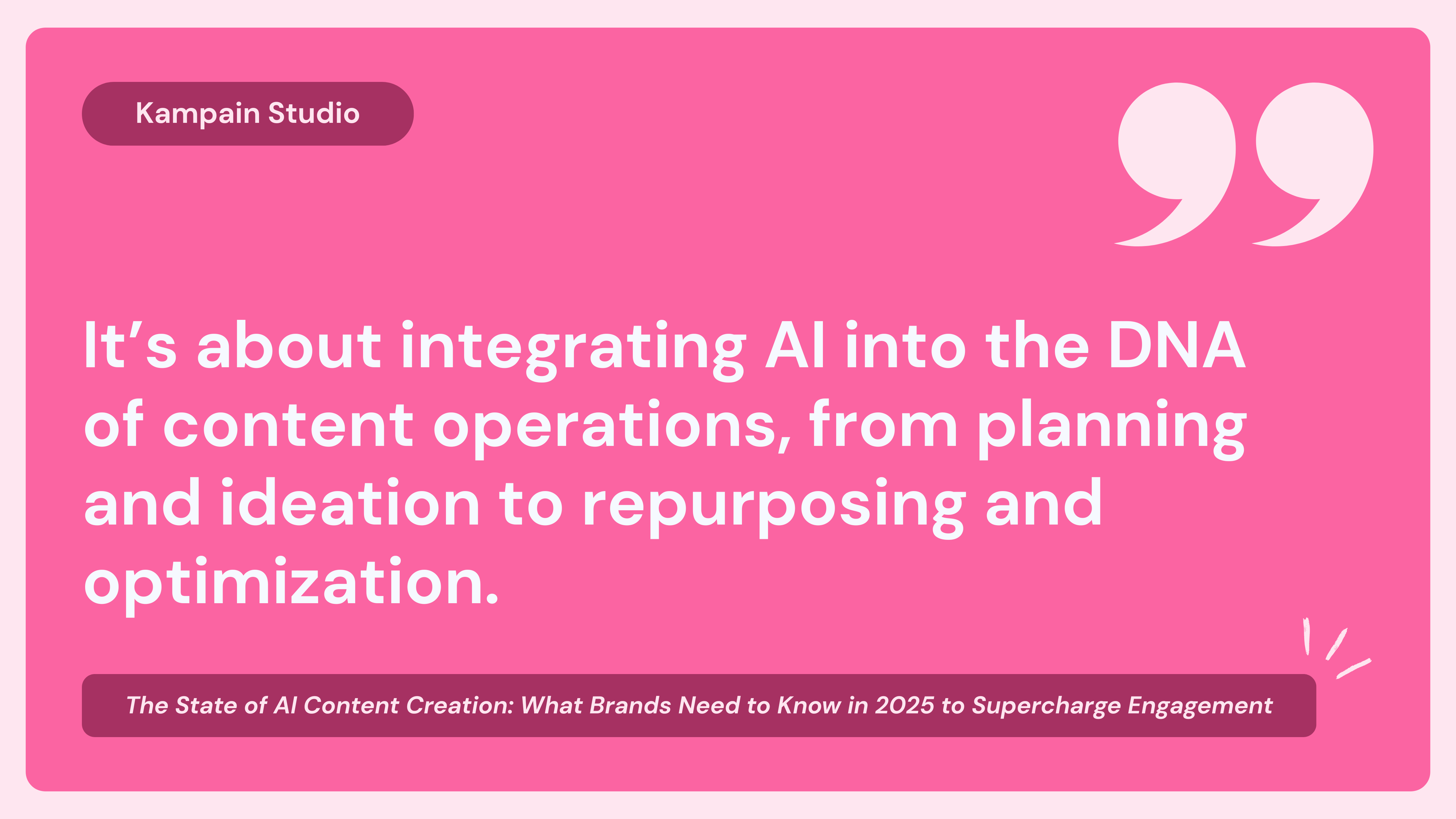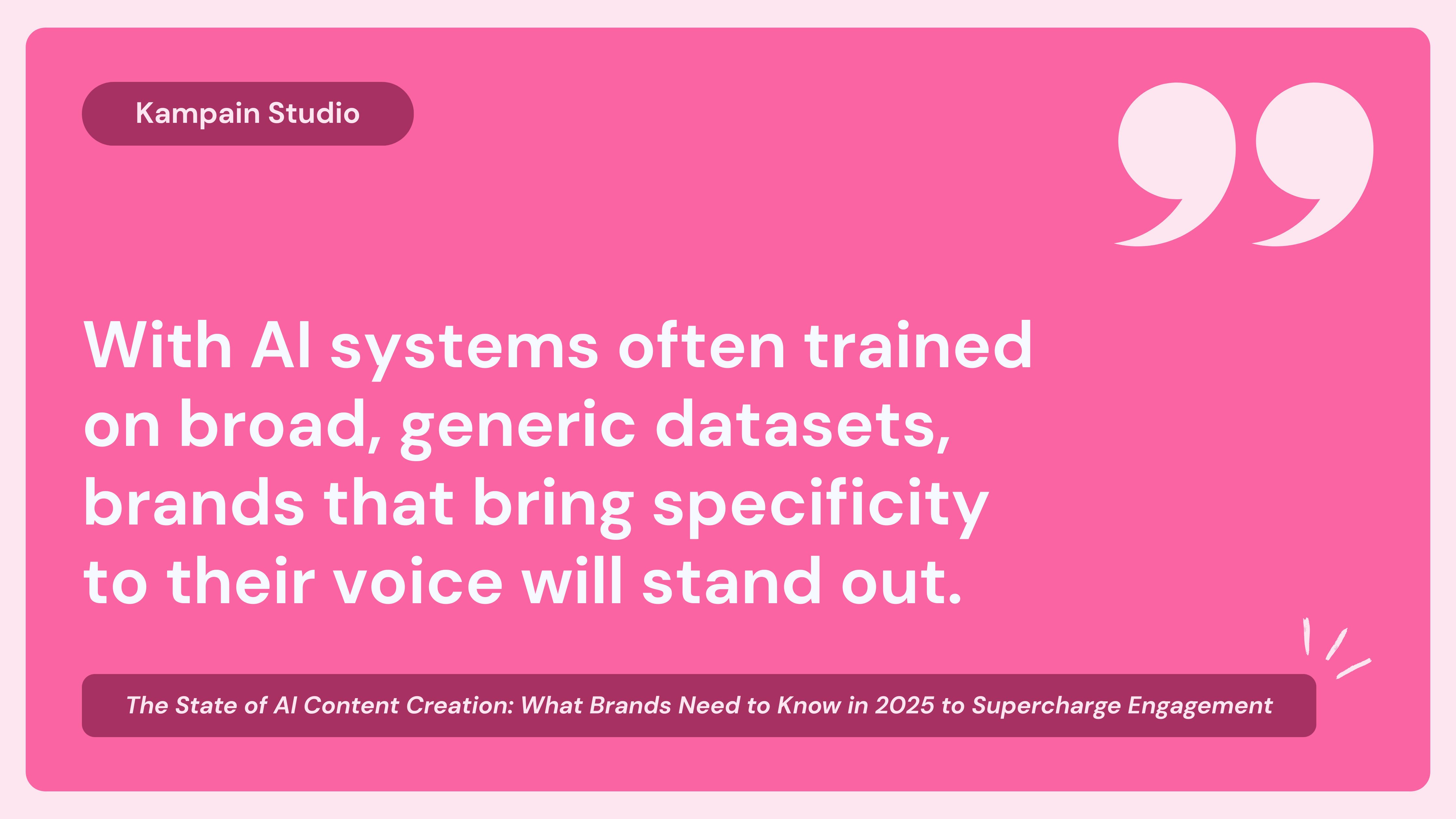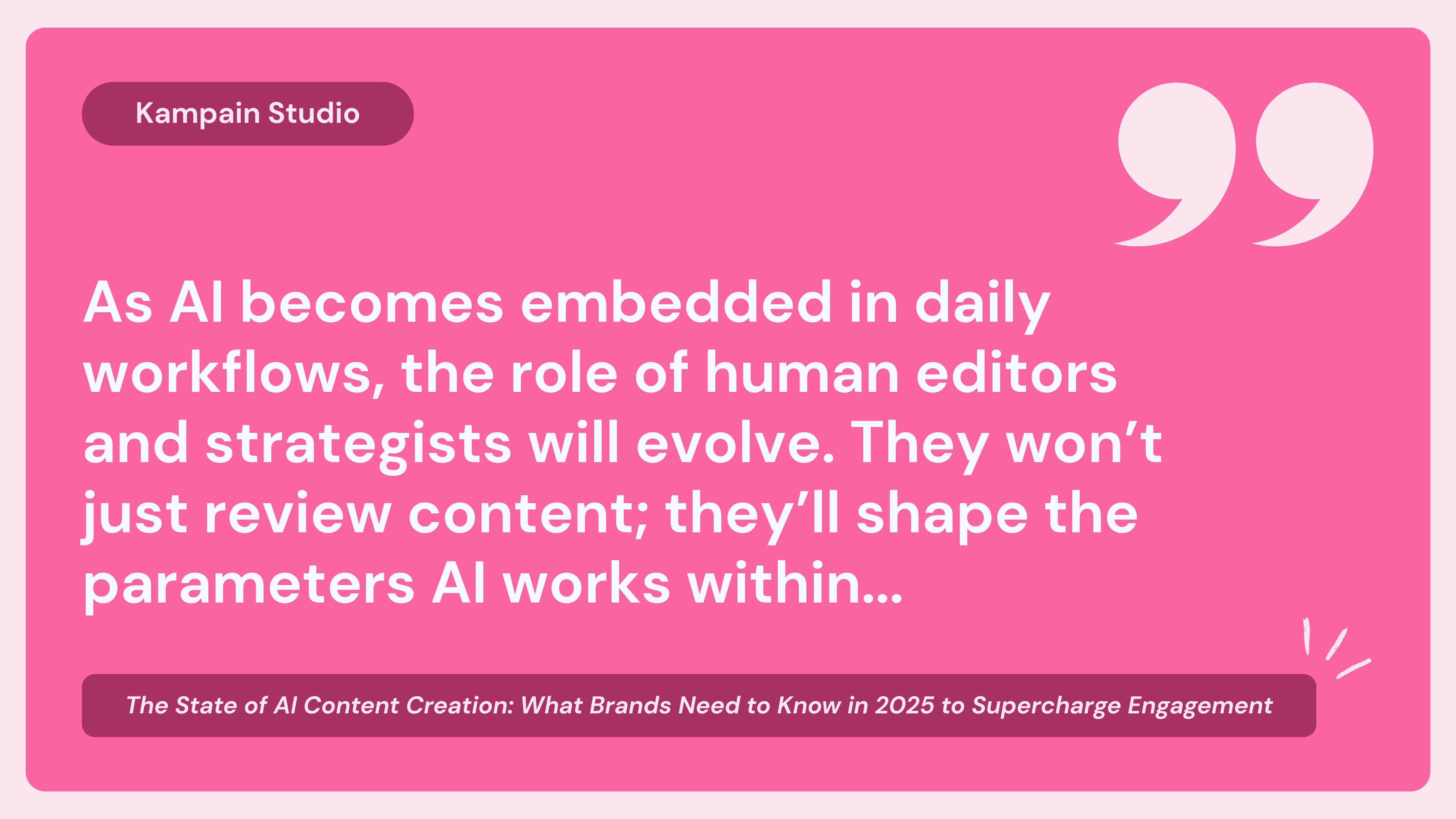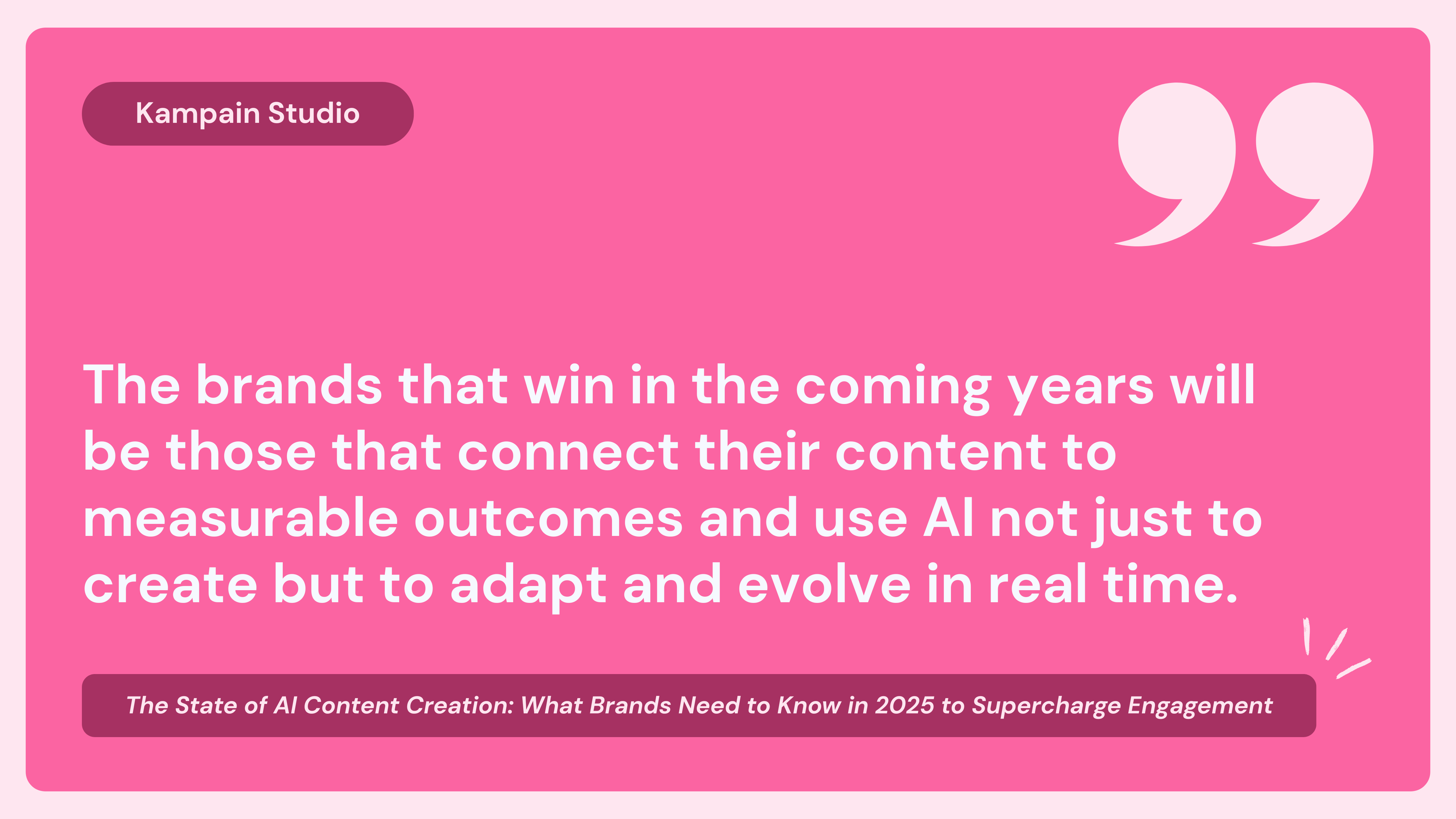In just a few short years, AI content creation has evolved from a promising experiment into a foundational part of modern brand strategy. In 2025, the question isn’t whether you should be using AI — it’s how well you’re using it to scale, differentiate, and create meaningful connections with your audience.
We’re witnessing a shift in the role of content: from volume-focused output to performance-driven experiences. With new technologies like personalized language models, automated creative assistants, and real-time engagement feedback tools, brands have more power than ever to produce content that’s both efficient and emotionally resonant.
AI-driven content creation has moved from novelty to necessity. In 2025, brands that embrace the evolving ecosystem of generative tools are setting themselves apart, not just in productivity but in how they connect, scale, and resonate with their audiences.
But as automation becomes more accessible, expectations are shifting. Brands need more than content at scale; they need voice, vision, and value. Here’s what you need to know to stay competitive, creative, and intentional with AI this year.
The role of AI in content creation is shifting from tactical to foundational for content strategies. In 2025, brands aren’t just using AI to produce more; they’re using it to build structured systems that support consistent, scalable, and strategic storytelling across the entire marketing funnel.
This shift goes beyond volume and speed. It’s about integrating AI into the DNA of content operations, from planning and ideation to repurposing and optimization. Expect to see more businesses treating content components as assets: built once, reused many times, and continuously improved by AI over time.
Today’s leading brands aren’t using AI just to write quickly — they’re using it to architect smarter content ecosystems. From strategic messaging frameworks to modular campaign assets, AI is powering workflows that align content with every stage of the customer journey.
In 2025, speed matters, but structure matters more.

Invest in a system that helps you create content that can be repurposed across channels and formats, not just one-off pieces. These components can take many forms: strategic messaging templates, prompt libraries, modular campaign frameworks, or structured outlines built for reuse across your entire funnel.
As more brands move toward omnichannel marketing, reusable AI-generated content blocks will be the cornerstone of efficient and consistent storytelling across email, blogs, social, and video.
Ensure your content strategy, not just production volume, is AI-informed. In 2025 and beyond, smart brands will embed AI into their content planning tools, using predictive models and audience behavior data to guide not only what gets created but when, where, and how it’s deployed.
As AI tools become more deeply integrated into marketing stacks, content creation will be increasingly cross-functional. Brands will need systems that allow marketers, writers, and analysts to co-create with AI, blending insights from different departments into a unified messaging approach. Look for platforms that support real-time collaboration, cross-team access, and AI-human workflow flexibility.
As generative tools become ubiquitous, tone is one of the last remaining brand signatures. Audiences are increasingly gravitating toward content that feels human, nuanced, and emotionally attuned, making brand personality not just a preference but a competitive advantage.
With AI systems often trained on broad, generic datasets, brands that bring specificity to their voice will stand out. A distinctive tone isn’t just about writing style — it’s about reinforcing trust and values across every interaction, whether in short-form social content or long-form storytelling.
With more AI content flooding the internet, sameness is a risk. Brand trust and loyalty increasingly hinge on tone: your ability to sound human, consistent, and aligned with your values.

Bake your brand’s personality into your AI workflows with defined voice, tone, and language preferences. Emerging tools now let you train AI models on internal documents, past campaigns, and customer conversations to generate content that truly sounds like you.
However, many AI systems struggle with memory or context persistence — especially across formats or over time. This often leads to subtle but noticeable inconsistencies in tone or phrasing. Building a centralized, repeatable framework for voice and context ensures that your content remains cohesive, no matter who or what generates it.
Rather than a static document, create a flexible, living framework that evolves with your brand and content. This system should include tone parameters, content archetypes, and platform-specific voice variations built directly into your AI workflows.
As we move into multi-format campaigns (from TikToks to case studies), a dynamic and accessible voice system becomes a key differentiator, ensuring trust and brand cohesion across increasingly fragmented spaces.
Don’t just optimize for SEO — optimize for human resonance. Newer LLMs are advancing in emotional intelligence, but they still require guided prompts and fine-tuning. Use AI to amplify empathy, but let humans shape the core message. Emotionally intelligent content connects with audiences on a deeper level, especially in moments of decision-making, uncertainty, or trust-building.
In 2025, brands will increasingly leverage AI to detect tone, sentiment, and even user intent. But without consistent human framing, these insights risk becoming transactional rather than transformational. To truly resonate, your content must reflect the emotional landscape of your audience, not just mirror trends.
In a world of infinite content, relevance is everything. The most effective AI-powered content strategies in the near future will be those that embrace personalization — not just for efficiency but to create timely, targeted, and meaningful interactions across every touchpoint.
Thanks to advancements in data-driven automation and CRM integration, AI can now generate audience-specific variations in seconds. But the real opportunity lies in combining real-time data with contextual storytelling, making your brand feel close, even at scale.
AI gives you the ability to tailor content by persona, funnel stage, or platform without the traditional time cost. But only if your strategy supports it.
Break down your audience into personas and create AI-powered content variations for each. Expect an increase in real-time personalization tools in 2025 that respond to behavior triggers (like product page visits or email clicks) with dynamic content generation.
Link your CRM, email, and analytics tools to your content process so that your messaging reflects real-time behaviors. AI-native marketing stacks are emerging that allow direct input of customer data into your content engine for highly relevant messaging.
Refinement is where the value multiplies. Generative systems are becoming more adaptive, learning from content performance to inform the next wave of output. Build feedback loops where engagement data directly informs what gets created next.
AI may be fast, but it isn’t flawless. The edge will go to brands that combine the scale of automation with the insight, judgment, and integrity of human oversight, ensuring content is not only efficient but also ethical, strategic, and on-brand.
As AI becomes embedded in daily workflows, the role of human editors and strategists will evolve. They won’t just review content; they’ll shape the parameters AI works within, provide creative direction, and step in when nuance, emotion, or risk come into play.
AI can draft, but it can’t replace insight. The brands leading in 2025 are those that know where to let AI scale and where to insert strategic human input.

Even great AI outputs need polish. With deepfakes, misinformation, and over-automation on the rise, human editors will serve as brand stewards — guardians of tone, accuracy, and ethics. Expect a growing demand for AI-savvy editors who understand both machine-generated structures and human nuance.
Establish collaborative workflows that include human checkpoints before anything goes live. Co-authoring tools are becoming the norm where humans and machines edit, comment, and revise in tandem. This approach helps avoid algorithmic errors while capturing new creative possibilities that AI alone can’t deliver.
Let your team guide the content’s purpose. In 2025, AI won’t just follow orders — it will surface suggestions. However, the best brands will still steer with intention, defining the strategy before handing execution to automation. Human leadership is especially essential when addressing sensitive topics, brand values, or unique cultural moments that AI may misinterpret.
AI's role in content creation is expanding beyond marketing. Sales, product, and customer support teams are beginning to shape what content gets made. Human oversight isn’t just about editing; it’s about integrating multiple perspectives across the organization so that AI-generated messaging truly reflects the business as a whole.
Content creation isn't just about publishing, but also performing. The brands that win in the coming years will be those that connect their content to measurable outcomes and use AI not just to create but to adapt and evolve in real time.
We’re entering an era where performance data has moved beyond reporting. It now feeds back into content production systems, prompting smarter decisions and sharper messaging. Brands that can operationalize these feedback loops will unlock compounding value from every piece they publish.
Creativity is powerful. But it’s not enough to just publish anymore. Content must be tied to results. With AI, you can track, adapt, and reoptimize faster than ever.

Connect specific goals to each content type, like engagement for blogs, conversions for emails, or reach for reels. Leading AI platforms will integrate directly with analytics dashboards to show content ROI in real-time.
Look at what’s working to shape what comes next. 2025’s content strategies will be guided not just by gut or trend, but by multi-channel performance intelligence gathered across platforms.
Feed top-performing language, formats, and topics back into your AI inputs for smarter future outputs. Some tools are beginning to auto-train prompts based on performance tags, helping you evolve content with each iteration.
AI is more than a tool for efficiency. It’s the backbone of modern content strategy. The brands that will thrive in 2025 and beyond are those that blend automation with intention, personalization with performance, and speed with strategy. By structuring AI-driven workflows, refining your brand voice, and keeping human oversight at the core, you can turn AI from an output machine into a true growth engine.
Kampaign Studio helps brands leverage AI strategically — not just to create faster, but to create better. From tone modeling to multi-format automation and performance feedback, we give you the tools to grow without losing your voice. Start your free trial today
